Diego Rivera is one of the most famous painters in the twentieth century. After studying in Spain and France, he returned to his homeland of Mexico. There he travelled across the country, exploring the cultures, architecture and history of the different regions. Returning to Mexico City, Diego began painting murals for which he became famous.
His painting “Mother’s Helpers” contains all the wonderful elements Diego Rivera is famous for: deep, rich tones, depiction of Mexico farm life and dark outlines.
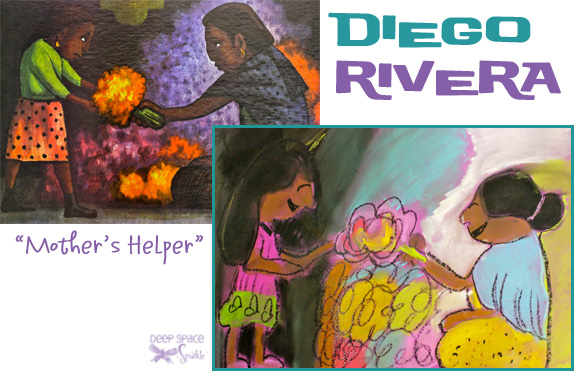
The Drawing
Fourth grade students used a black oil pastel and purple 12″ x 18″ sulphite paper to sketch the woman and child. I helped them along by drawing the steps on the whiteboard how to draw the girl and the woman. Take some time to point out the gentle slope of the woman’s head, shoulders and back. The line extends from the top of her head to the curve of her knee. So simple and beautiful. Point out that the heads are out of proportion with the bodies and that children shouldn’t worry if their bodies and heads are perfect. If it works for Diego, it’ll for for them!
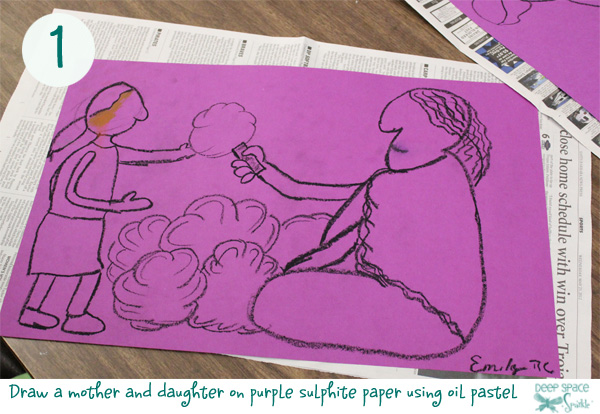
The Coloring
I place trays of chalk pastels on each table. Use newspapers to cover the desks. Here are a few tips for working with chalk:
Understand that chalk is a messy medium and that it’s okay for a child to get messy. Clean-up is easy with baby wipes placed at the end of each table.
Use one finger to blend chalk. Think of moving the finger around in little circles, pressing the chalk into the paper fibers.
Use a flat end of the chalk whenever possible for this lesson. Children will want to avoid using a sharp angle to color as it takes longer.
Spraying often distorts the artwork so I rarely spray. Instead, I use newspaper to cover the artwork.
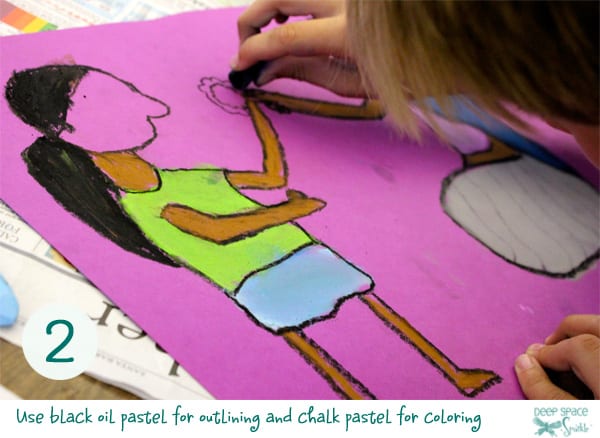
The Outlining
The final step is to use a black oil pastel and a black chalk pastel to outline and to add shadow and depth. This is one of the few times I allow my students to use black chalk pastel. Most of the time, it is hidden away in a separate box!
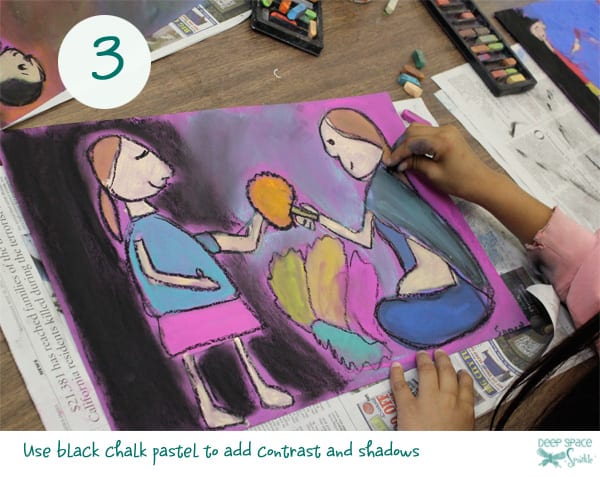
Fourth grade Diego Rivera chalk drawings…
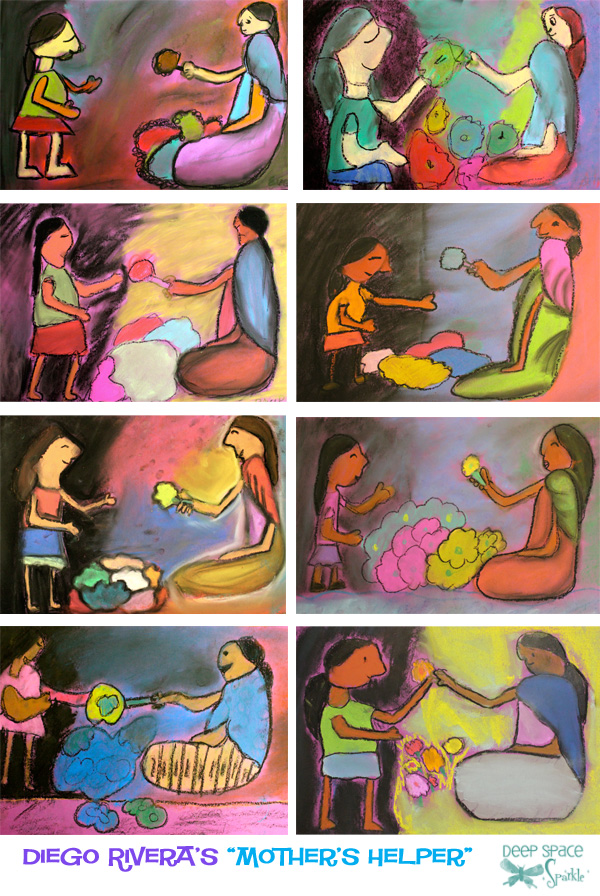
Want another lesson idea for your Mexican art unit? Download this free PDF by clicking below and we’ll send you our Sugar Skull Drawing Guide!

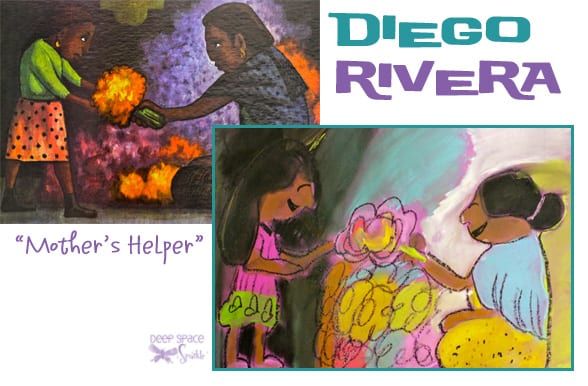











Hi! Can you please tell me where the original painting is located? I’m having a hard time finding it!!
Thank you so much, I love this site!
Ingrid
Hi,
I dont have a good URL, but try doing a google sear ch or look at some art poster websites. Good luck!
Ingrid,
Did you find the location of the original Diego Rivera’s Mother’s Helper? If you did can you share the information?
Al
Attached you´ll find the link where you can see the original.
Best Regards,
Gaby
http://www.diego-rivera-foundation.org/Mothers-Helper.HTML
These came out beautifully! The added touch of black oil pastel line and chalk pastel shadow really brings out the colors. Pinning!
You make it look so easy. I took a pastels class recently and it was HARD. I’m not good with messy. Great job. My girls would love this exercise.
I like this theme. Rivera’s murals can sometimes be a little deep for elementary, so this is very appropriate for sharing his work with younger viewers, especially paired with a Kahlo still life. Thanks for sharing.
I was looking for an art lesson to celebrate Labor Day and also the Hispanic background of many of my students. Your lesson on “Mother’s Helper” along with a bulletin board featuring California Allegory will be perfect together. What a Great website!!!
This is beautiful and would make a wonderful Mother’s Day project.
I’ve been visiting you for a while for your wonderful ideas. I’ve just started my own blog and have added your link to follow. Thanks so much for the inspiration!
Elizabeth
I am not familiar with sulfite paper….is it slicker than construction paper or is it just a better quality construction paper? Our main source here is Hobby Lobby and they do not list it as available on their website. We are doing a study on Mexico so we are looking at this lesson as a perfect way to introduce Diego to the children. We LOVE DSS!
Here’s how I explained sulphite paper in my art supply PDF:
“Sulphite is a process that extracts the lignin from wood chips and produces pure cellulose
fibers. This means that sulphite paper is a smooth, white and inexpensive drawing paper
that is perfect in any art room.
I use sulphite paper in every art project that uses tempera paint, markers, collage, etc. The
only time I do not use sulphite paper is when I am teaching a watercolor blending lesson.
For that I use a cheap school-grade watercolor.
For your home-school environment, I would stock up on 50-sheet packs of sulphite paper. It
is cheap, holds up very well to all paint and is what every art teacher uses.”
And yes, it’s basically smoother, more expensive construction paper. Hope this helps!
Thanks so much Patty! It’s crazy how hard it is to find it here. I am going to order some from an office supply store just b/c I am curious as to the difference in it, We did stage one of this project today and the kids are excited about using the “forbidden” chalk pastels 🙂 We used our class time today to divide the paper into a grid and have them practice the shapes they wanted to accomplish on the “real” paper. This is a new process for them and I was amazed at how observant they became when we broke it down like that. This is a wonderful piece of art for them to focus on and really highlights the beauty of Rivera’s Mexican heritage. Thanks again.
Thanks, Paula. This lesson was a bit of a surprise for me. I loved the way it turned out and the kids really enjoyed learning about Rivera.Glad you like it, too!
Thanks Patty, this was exactly the inspiration I was looking for to reinforce the concept of contrast with fourth grade. Keep the great ideas coming and as always, thanks so much for sharing!
Did you have the students sketch in pencil first, then outline in pastel, or do it all with black pastel from the beginning?
I’m excited to try this with my class.
Oil pastel right from the beginning. I rarely use pencils as the kids will take too long and will draw small. Not the best medium for this particular project.
Do you think this lesson would work for 2nd grade?
Im wondering the same thing.
I started using this website for ideas ever since we went virtual for teaching. I teach 2nd grade, and last year tried this project for Cinco de Mayo. The 2nd graders loved it. I had sent home watercolors, but as we know, not all students were able to pick up their supplies, so I just let students use what they had at home.
I am looking forward to trying it as described here with the oil and chalk pastels.
Not sure if it’s OK to share websites, but here is a link to the pics:
https://room22rockstars.blogspot.com/2020/05/an-excuse-to-paint-cinco-de-mayo-and.html
Thank you!
Tamar
Love the resources and ideas
I like how they do their art and I think it is unike
I like how they drew the paintings and it’s a great way to do the painting